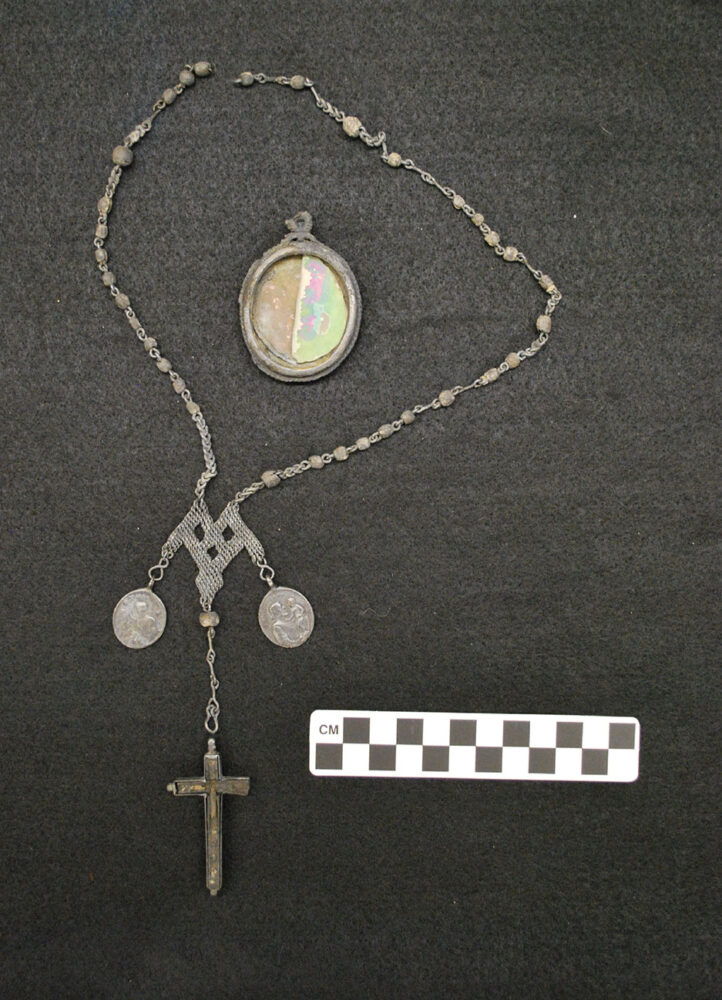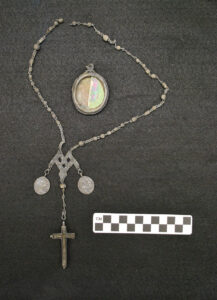St. Peter Street Cemetery
Thousands of New Orleans’s eighteenth-century residents are interred at the site of the St. Peter Street Cemetery in the French Quarter.

State of Louisiana
Medallion and Crucifix recovered from St. Peter Street Cemetery. UNO Archaeology Lab, photographer.
The St. Peter Street Cemetery was one of the earliest-known formal burial grounds in New Orleans. Colonial-era maps show it on the block bounded by St. Peter, N. Rampart, Toulouse, and Burgundy Streets in what is now the French Quarter. The block was established as a cemetery by the 1720s. It was closed in 1789, though it appears to have still occasionally been used for burials until it was subdivided for public auction in 1801. Private owners developed the block with residences and businesses soon afterward. Since then, human remains have been discovered on the block numerous times. Thousands of the city’s eighteenth-century residents are still interred at the site.
While the location of the first burials in New Orleans is the source of speculation, the cemetery on St. Peter Street is depicted on maps as early as 1725, when it only occupied half of the present block. It was never formally named in French or Spanish colonial documents. While wealthy and influential people were buried at the St. Louis Church (the future site of St. Louis Cathedral), the St. Peter Street Cemetery appears to have served most everyone else, free or enslaved, provided they professed the Catholic faith. While eighteenth-century burial records are incomplete, they provide a glimpse of those interred in the cemetery, including people of African descent, European-descended settlers, native-born Black and white people, and Indigenous Americans. The cemetery block’s ownership was disputed at the time of its auction, with the Spanish city government and the Catholic Church both claiming possession. The new American city administration recognized the sale of individual lots to private owners as legal in 1810, and development proceeded rapidly thereafter.
The graves have been subject to disturbance many times over the years. The first documented disturbance occurred in 1893 when the Times-Democrat described three coffins encountered during the excavation of a well at a lot on Toulouse Street. The first time that archaeologists were able to formally examine the St. Peter site came in 1984, when local media revealed that a privately funded building project disturbed numerous graves on the block, leaving human remains and coffin fragments littering the construction site. Jurisdiction over the cemetery was not clear at the time. After negotiations between the Louisiana Division of Archaeology, the City Attorney, the Department of Safety and Permits for New Orleans, the Archdiocese of New Orleans, the Orleans Parish District Attorney, and the property developer, archaeologists from Louisiana State University (LSU) were given a brief window to salvage burials that had already been exposed by construction. They eventually recovered twenty-nine individuals, many of whom were interpreted to be people of African descent who had been enslaved during their lives. This discovery likely represented only a small fraction of those whose resting places had already been disturbed during construction on this lot.
While city authorities discussed possible legal protections for unmarked historic cemeteries in New Orleans after the 1984 discovery, they took no action at the local level to preserve the St. Peter site, and the Vieux Carré Commission, normally tasked with protecting and preserving the historic character of the French Quarter, expressly identified archaeological preservation as outside of the scope of its mission. However, in subsequent years, Louisiana developed more robust protections for unmarked burials and cemetery sites. No additional archaeological work occurred at the St. Peter Street Cemetery until 2011, when a property owner planned to build a swimming pool in a different lot on the block. After archaeologists confirmed that graves were present in the area, they developed a plan to exhume those individuals whose remains would have been disturbed by the construction project, transfer them to the LSU Forensic Anthropology and Computer Enhancement Services Laboratory for analysis, and then rebury them in an active cemetery in New Orleans after outreach to potential descendants. A team of archaeologists and forensic anthropologists recovered the remains of another fifteen individuals at the site and documented the presence of many more graves preserved beneath buildings.
Most of the people whose remains have been recovered during the two efforts to date appear to be of African descent, and at least some also show signs of mixed Native American ancestry. It is also likely that at least some of the individuals were enslaved in life, something that was indicated by pathologies suggestive of shackling on one individual’s ankle, healed parry fractures (produced when the forearm is used to ward off blows), and signs of heavy physical labor and dietary stress on bones. Most people buried at St. Peter Street appeared to have been buried below ground in unmarked graves, usually in simple cypress coffins. Bodies were most likely washed after death and wrapped in a simple linen shroud to be buried. This practice meant that, when items were included with bodies, they probably held special significance for the individuals, their families, or others around them. For instance, one of the only people buried with any items from the 1984 dig was a middle-aged man of African descent with filed teeth. He was interred with a crucifix and a suite of religious medals, items that presumably marked him as having special status when he was alive.
In 2015 the human remains recovered from the St. Peter Street Cemetery in 2011 were again laid to rest in a vault in St. Louis Cemetery No. 1. This reinterment was commemorated with a memorial mass at St. Augustine Catholic Church, followed by a procession and a “Celebration of Remembering and Healing” organized by the Umoja Committee, a local community and cultural group. Despite the renewed attention from local media, the cemetery remains unmarked. While Louisiana state law forbids the desecration of cemeteries, it is often up to property owners to make sure that what they are doing does not impact human remains at a site like the former St. Peter Street Cemetery. There are still no specific protections for archaeological resources in the French Quarter despite their importance as an irreplaceable part of the city’s past.
